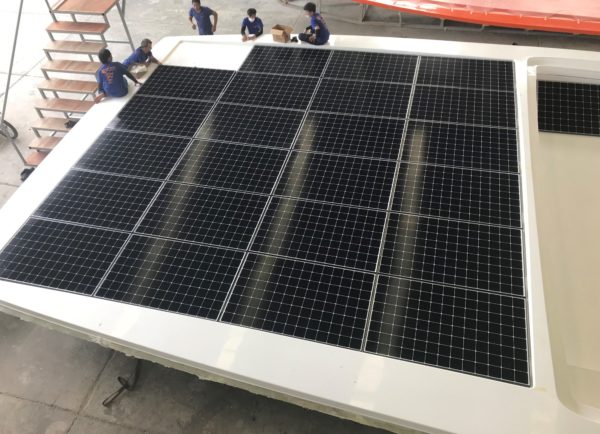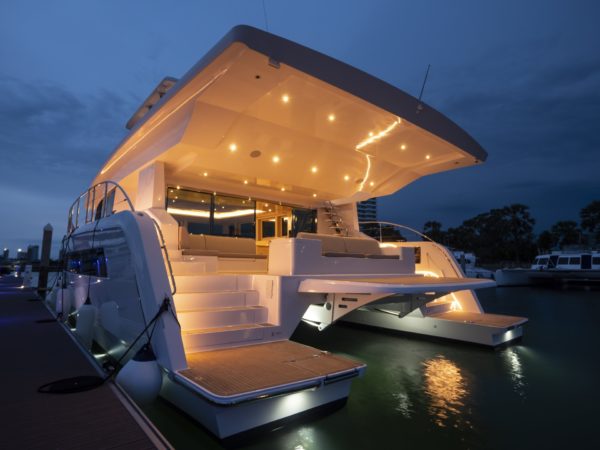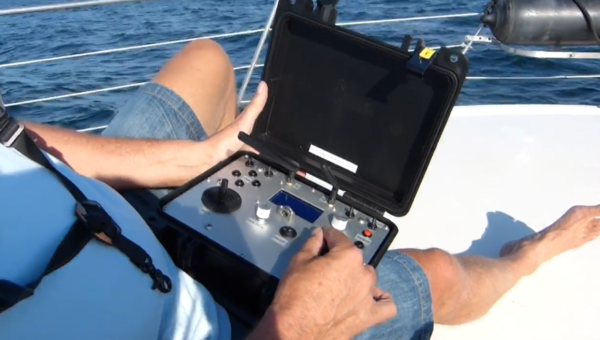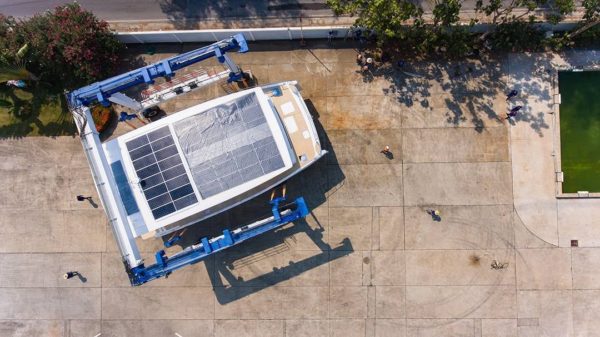Silent Yachts released an upgraded version of its solar-powered Silent 60 yacht, which now comes with an optional kite, adding wind power without shading the panels.
The vessel is 59 feet long, has a 29.5 foot width at the beam, and displaces 29 tons of water. Pricing for the Silent 60 starts at $2.58 million. The full range of products range from $2.34 million for the Silent 55 through $6.54 million for an 80-foot, three-deck model.

The vessel comes with 42 solar panels, outputting around 16.8 kWdc. The SunPower solar modules – probably a 400W Maxeon – are offered with a standard 25-year warranty. A 10 kW inverter is included, along with an 80 amp charge controller coupled to the energy storage system.
The lithium-ion battery ranges from 143 kWh for the Cruiser, through 286 kWh for the E-Power+. Yachting World magazine noted two years ago that a previous model’s batteries were manufactured by Panasonic.
The electric motor size and top speed increase with the battery size. The E-Power+ can cruise up to 100 miles per day on solar power alone, reports claim.
And while its sister ship, the SILENT 64, was “the first fully solar powered production yacht in the history of nautical travel” to cross the Atlantic Ocean, the luxury yacht comes with liquid fuel resilience, just in case.

The ship can sail all day at 6-8 knots, but it’s only able to travel at its top speed for about 30 minutes before running out of juice. In order to outrun storms or return to shore quickly after the sun sets, a backup generator at 100 and 150 kW is powered by two 300-liter diesel tanks.
But with good planning (and even a little luck), the generator isn’t necessary. In an interview with Yachting World, the builder noted a customer’s proud proclamation of having enjoyed his yacht for two years without using the generator at all.

The solar panels are not just responsible for the craft’s locomotion, but also for its reverse osmosis water makers, a full kitchen, LED lighting, and TV. Laminates were used where possible to reduce weight. The hull has extra layers of thermal insulation to keep heating and cooling loads down, and many windows have been deliberately placed out of the direct sun.
The already-silent and energy-efficient vessel has now added an option of a WINGit kite boat system. The wind kit manufacturer has a video showing the wind pulling a boat at just over 6 knots. The nearly 60-foot-long Silent Yacht is said to be able to reach 4-5 knots with the kite alone.
The manufacturer of the wing kit suggests that it generates up to 10 times more power per square meter than a conventional sail. The 140-square-foot unit attaches to a two-foot mast via four Kevlar ropes. After the kite fills with air, it’s let loose to drift up off the yacht, eventually reaching nearly 400 feet.

The sail traces a figure eight above the boat, and the captain can steer it with a joystick or an app on an android phone, says Köhler, the company’s founder.
The solar yacht may be cool, but it represents part of an emerging trend in the transportation sector.
Starting in 2016, transportation emissions in the U.S. were greater in volume than those produced by power generation.

Globally, S&P suggests that the shipping industry represents 2-3% of all emissions.
A.P. Møller – Mærsk A/S, one of the world’s largest shipping companies, plans to launch its first carbon-neutral vessel by 2023, and hopes to have a zero-emission vehicle by 2030 as part of its broader 2050 zero-emissions goals.
Some of the first large battery powered ships started in the ferry industry, mostly in Scandinavian nations. Currently, one of the world’s largest ferries is the largely autonomous 7 MW/4 MWh Bastø Electric, which is capable of making two dozen 30- minute trips per day.
This content is protected by copyright and may not be reused. If you want to cooperate with us and would like to reuse some of our content, please contact: editors@pv-magazine.com.








John, sorry, I don’t get the Bob Marley connection. If you’re referring to the song “The Tide is High,” the Jamaican original was written by John Holt and sung by Holt and the Paragons in 1967, while Blondie’s version topped the charts in 1980. Or am I missing something?
Editor: Have a look here:https://www.youtube.com/watch?v=_slaGoV0FTk